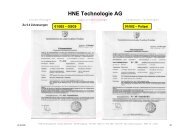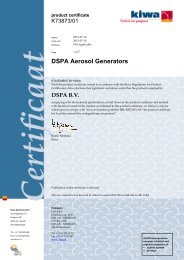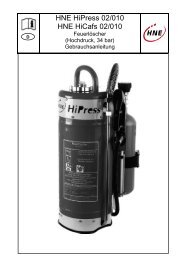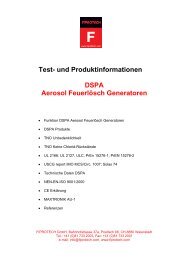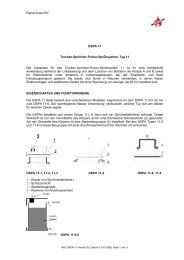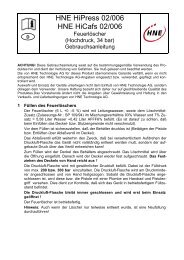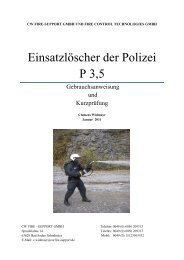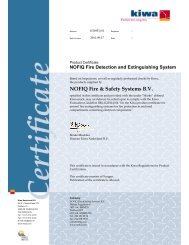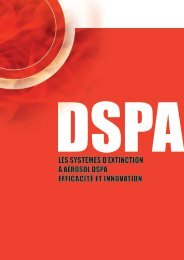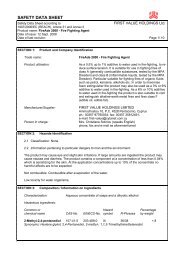FireAde 2000 Hydrocarbon suspension technology - Flame Guard
FireAde 2000 Hydrocarbon suspension technology - Flame Guard
FireAde 2000 Hydrocarbon suspension technology - Flame Guard
You also want an ePaper? Increase the reach of your titles
YUMPU automatically turns print PDFs into web optimized ePapers that Google loves.
The new <strong>technology</strong> for fighting fires, toxic vapours and contamination<br />
<strong>FireAde</strong> <strong>2000</strong> allows for the absorption of about ten times as much heat energy as ordinary water.<br />
covalent ends of the <strong>FireAde</strong> <strong>2000</strong> molecules project<br />
from the water droplets. The all-round channelling<br />
of heat into the droplets prevents the droplets from<br />
”shooting off“ as a result of asymmetrical water<br />
vapour formation when they are heated from one<br />
side only.<br />
The droplets of the <strong>FireAde</strong> <strong>2000</strong>/water mixture<br />
look like pin-cushions with projecting pins. As these<br />
droplets come closer to a fire, the <strong>FireAde</strong> <strong>2000</strong><br />
molecule acts as a heat conductor that channels the<br />
heat to the inside of the droplet.<br />
<strong>FireAde</strong> <strong>2000</strong> was developed in such a way that not<br />
only the outer surface of the water droplets but also<br />
their inner volume is effectively used. The following<br />
could be proven, both during experimental studies<br />
and during design calculations:<br />
<strong>FireAde</strong> <strong>2000</strong> allows for the absorption of about<br />
ten times as much energy as ordinary water.<br />
Heat reduction using <strong>FireAde</strong> <strong>2000</strong> is more<br />
efficient than using of foam, which isolates<br />
the thermal load.<br />
Temperature reduction<br />
Method in comparison to AFFF foam<br />
This test shows the marked difference in the<br />
cooling efficiency between <strong>FireAde</strong> <strong>2000</strong> and<br />
traditional foam.<br />
The test objects were two steel plates with a thickness<br />
of 2 cm and an edge length of 15 cm. Both<br />
plates were continuously exposed to a extinguishing<br />
stream. The initial temperature was over 600<br />
degrees centigrade. The test period amounted to<br />
60 seconds of cooling. Immediately after this<br />
period, the plate cooled with <strong>FireAde</strong> <strong>2000</strong> had<br />
a temperature that prevented reignition.<br />
Foam cooled the plate far more slowly and a<br />
significantly greater amount of cooling liquid<br />
was required.<br />
Unlike the foam in fire class B, which isolates the<br />
thermal load, <strong>FireAde</strong> <strong>2000</strong> rapidly reduces the<br />
temperature of the thermal load (as well as of the<br />
adjoining infrastructure) to below the self-ignition<br />
temperature. A very short extinguishing time is<br />
achieved in combination with the foam film.<br />
The rapid heat reduction of <strong>FireAde</strong> <strong>2000</strong>, together<br />
with its separation effect, considerably reduces<br />
spontaneous reignition, as the vapours are separated,<br />
while simultaneously rapidly reducing the<br />
temperatures to below the self-ignition temperature.<br />
When simulating ”flash over“, the fire fighters<br />
usually crouch down in the vicinity of the simulator.<br />
Burns may occur as a result of the considerable<br />
formation of water vapour. When simulating "flash<br />
over" situations, the use of <strong>FireAde</strong> <strong>2000</strong> leads to a<br />
low risk of burns as a result of its rapid cooling and<br />
minimal water vapour formation effect.<br />
600° C<br />
500° C<br />
400° C<br />
300° C<br />
200° C<br />
100° C<br />
0° C<br />
AFFF foam<br />
<strong>FireAde</strong> <strong>2000</strong><br />
0 10 20 30 40 50 60<br />
seconds<br />
7<br />
®




